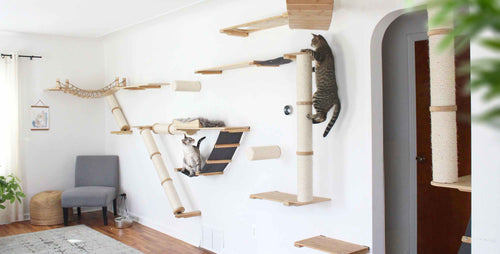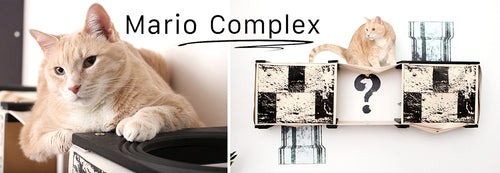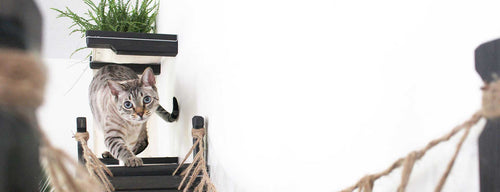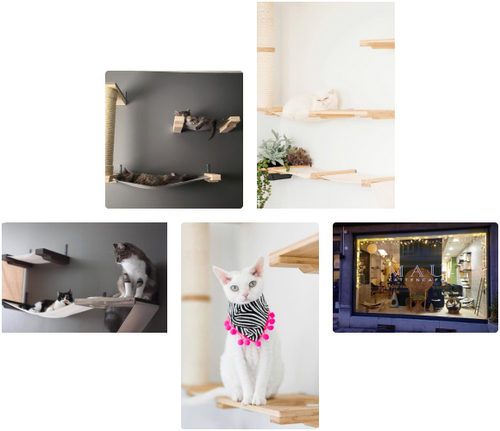When constructing the ideal habitat for your cat, several factors should be taken into account. We provide an extensive selection of wall-mounted cat trees, incorporating design elements that address various crucial aspects to ensure your cat's satisfaction. However, many people prefer assembling their DIY cat walls, tailoring the products to suit their space perfectly. Here are some tips to optimize your furniture layout while designing your cat wall.
STARTING AND ENDING POINTS
- Accessibility: When introducing your cat to wall-mounted furniture, it's essential to begin with platforms that are easily reachable. A low starting point ensures your cat feels safe and encourages exploration. We recommend placing the initial shelf or hammock around 14" off the ground.
-
Incorporate Incentives: Incentives play a crucial role in cat wall design. Our wall-mounted cat trees are designed to create a pathway leading to areas for eating or lounging. If you're crafting a DIY cat wall, consider this aspect when planning the layout.
-
Cat Wall Spacing: So what is the spacing for cat wall steps? This largely depends on your cat's size and fitness level. Generally, we recommend spacing them around 12-18 inches apart. However, you'll have the best understanding of how far your cat is comfortable jumping.
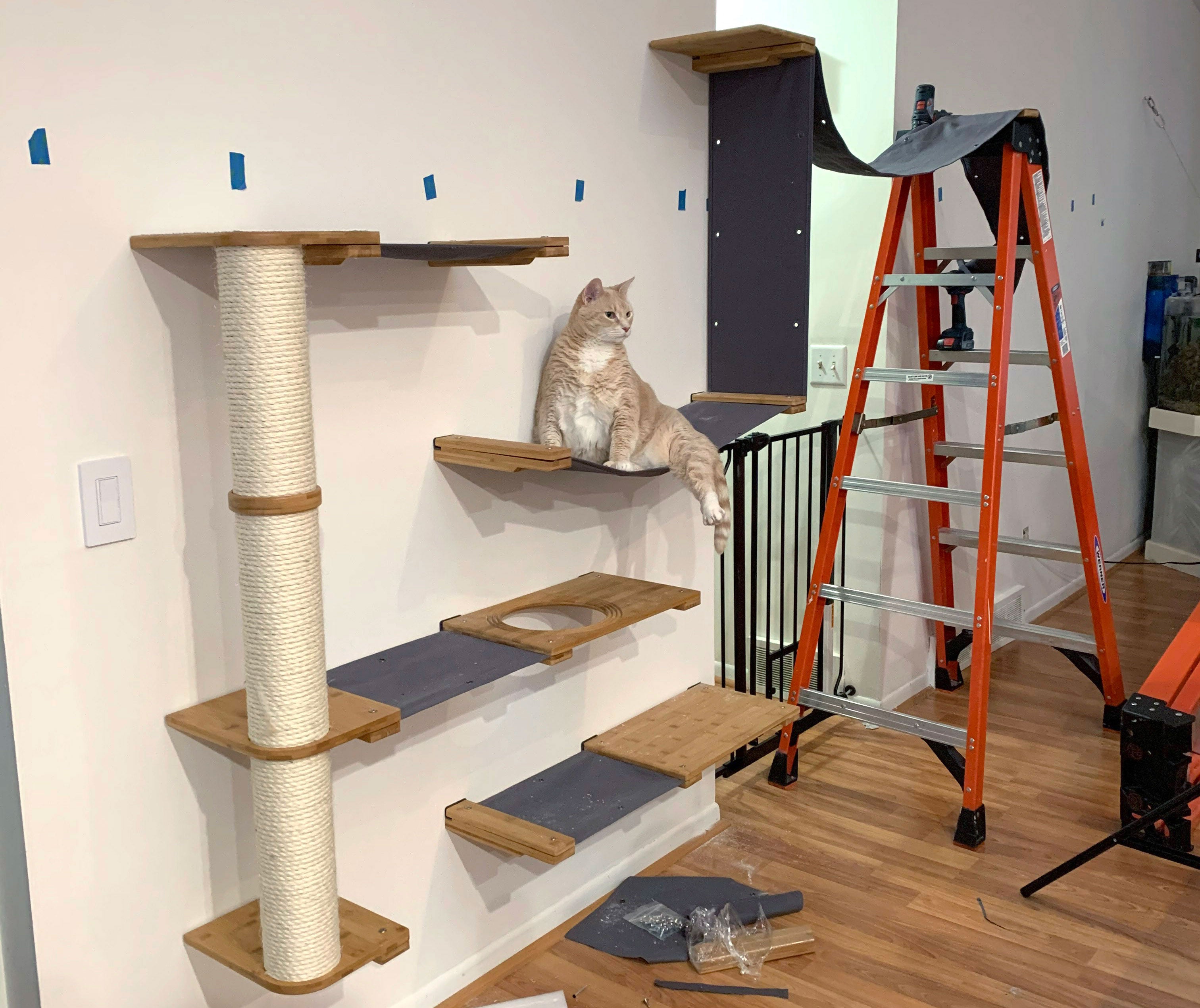
UNDERSTANDING YOUR CAT
The optimal design for a cat wall depends on the individual cat. Factors such as age, temperament, and energy level greatly influence what would suit them best. Our recommendations for different cats vary based on their physical abilities and privacy needs. Here are key aspects to consider when creating a cat jungle gym tailored to your feline friend.
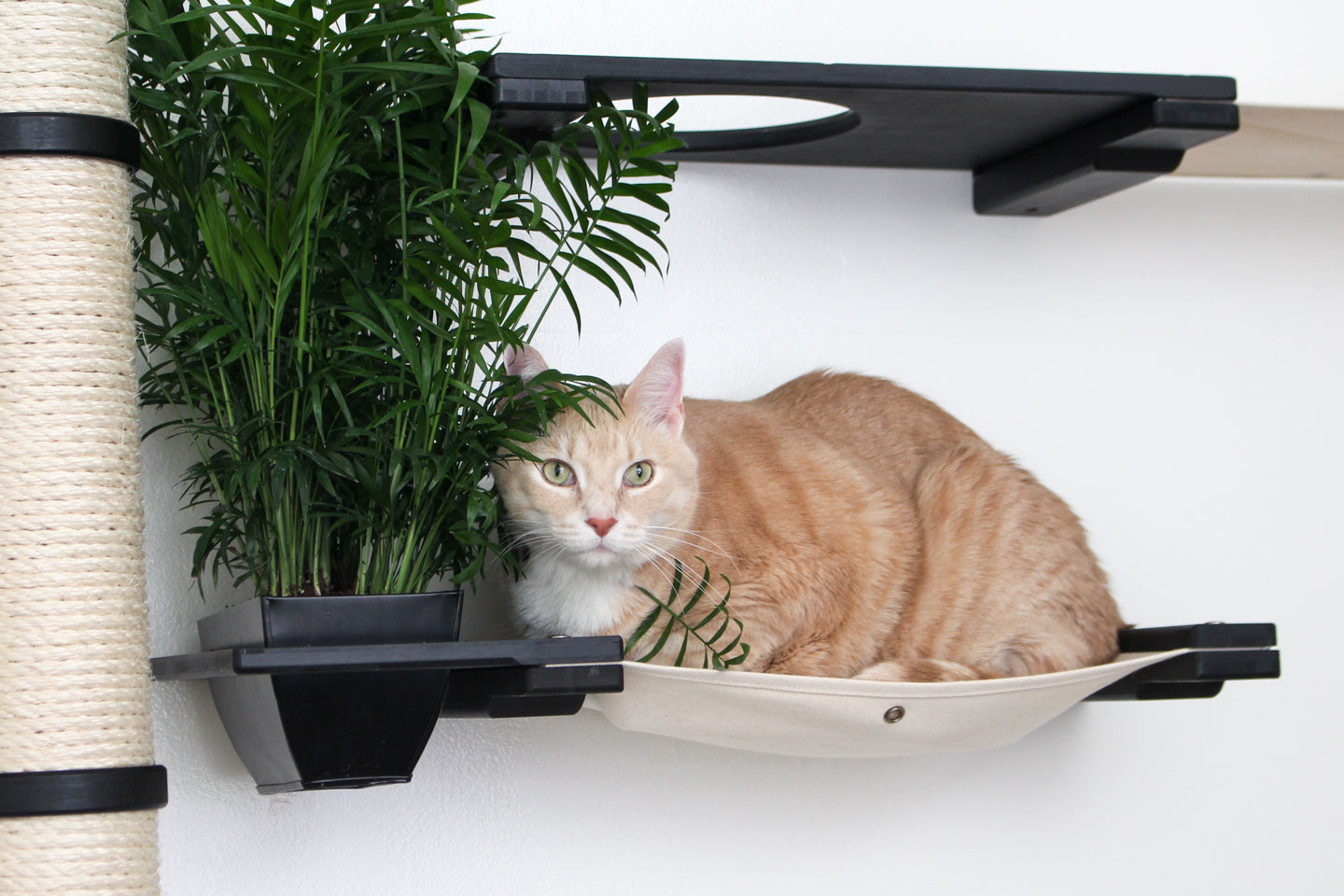
-
Kittens & High-Energy Cats: Young, energetic cats adore scratching poles, and we offer a variety of types to choose from. Consider incorporating a route on the wall that allows for sprinting around the home.
Recommendations: The Juggernaut, Scratching Post, The Crossroads.
-
Older or Disabled Cats: As cats age or face mobility challenges, they seek comfortable lounging spots. Utilize cat wall furniture to create easily accessible routes while encouraging gentle exercise.
Recommendations: Shelves, The Nest Cat Bed, The Lift.
-
Timid Cats: Provide hiding spots that still allow observation of surroundings.
Recommendations: Cat Cubbies, Grotto Cat Tree, Overlook Cat Tree.
-
Homes with Multiple Cats: Ensure ample space for multiple cats to gather simultaneously and incorporate multiple routes to prevent potential conflicts.
Recommendations: The Juggernaut, Overlook Cat Tree, Deluxe Cat Fort.

CORNERS, DOORS, AND WINDOWS
When it comes to designing around these, it’s important to first locate your studs because even though wall studs are typically spaced consistently along walls, they are often found spaced differently near corners and doorways.
For more information on wall construction, stud & how to locate them, please see our installation guide

Installing Around Corners
We’ve found corners to be a very desirable location for cat perches or beds. They offer cats a great vantage point to observe their surroundings.
Our best option for extending walkways around corners is the Slotted Cat Shelf. It has slots running down the length of the shelf to provide more options for where you can attach the Shelf to a Mounting Plank. This allows you to connect the Shelf to the wall with two Planks while leaving half of the Shelf extending past the wall.

Another nice option for the outside corners is our Cat Perch Shelf. Since this Shelf is attached to a single Plank from the middle of the shelf, you can install it on the edge of the wall to create a route around a corner.
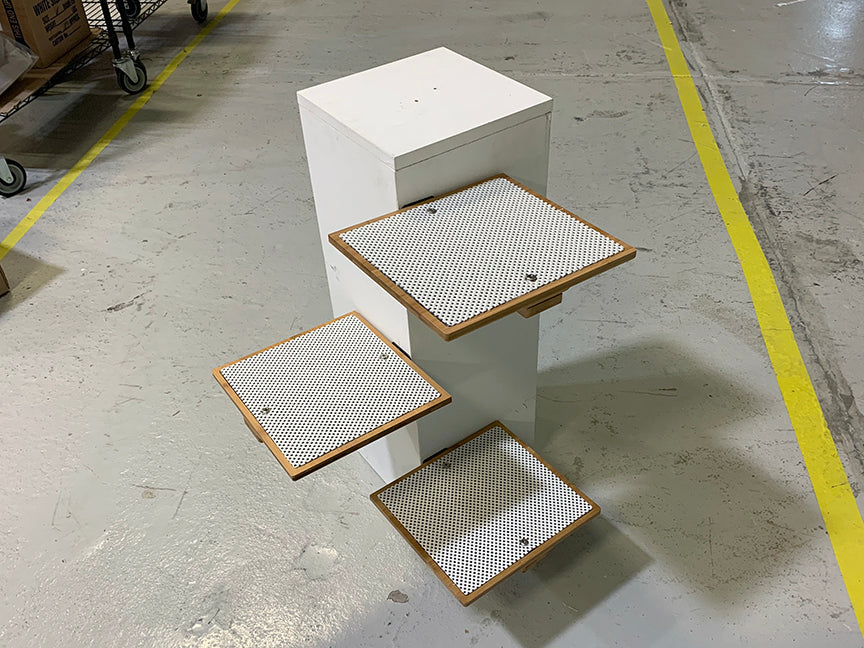
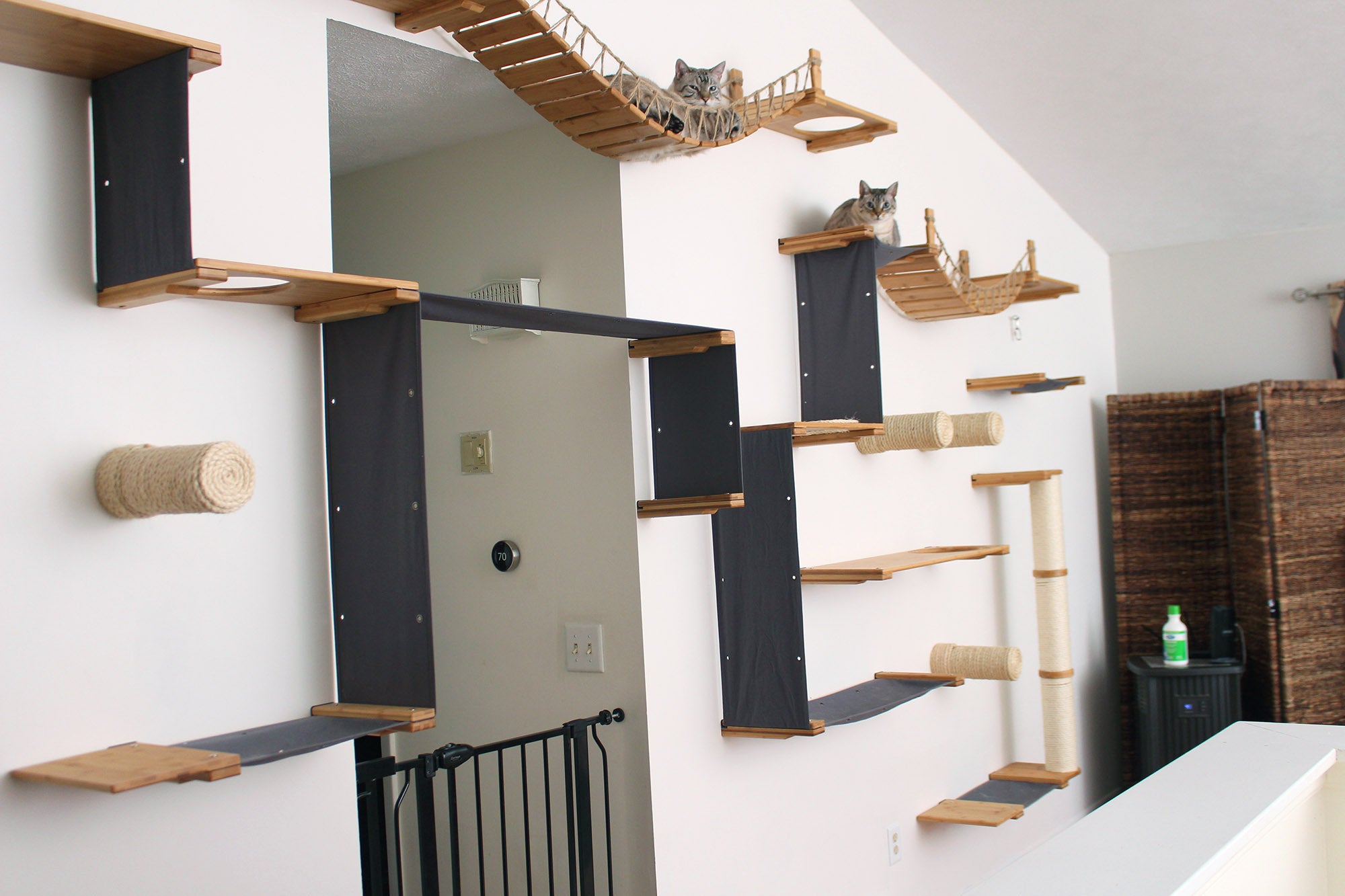
Cat Walls Inside Corners
We’ve designed a Corner Cat Bridge specifically meant for connecting a cat wall route along an inside corner. You can choose between four different layout options for each length by connecting them to the 34” Slotted Shelves.
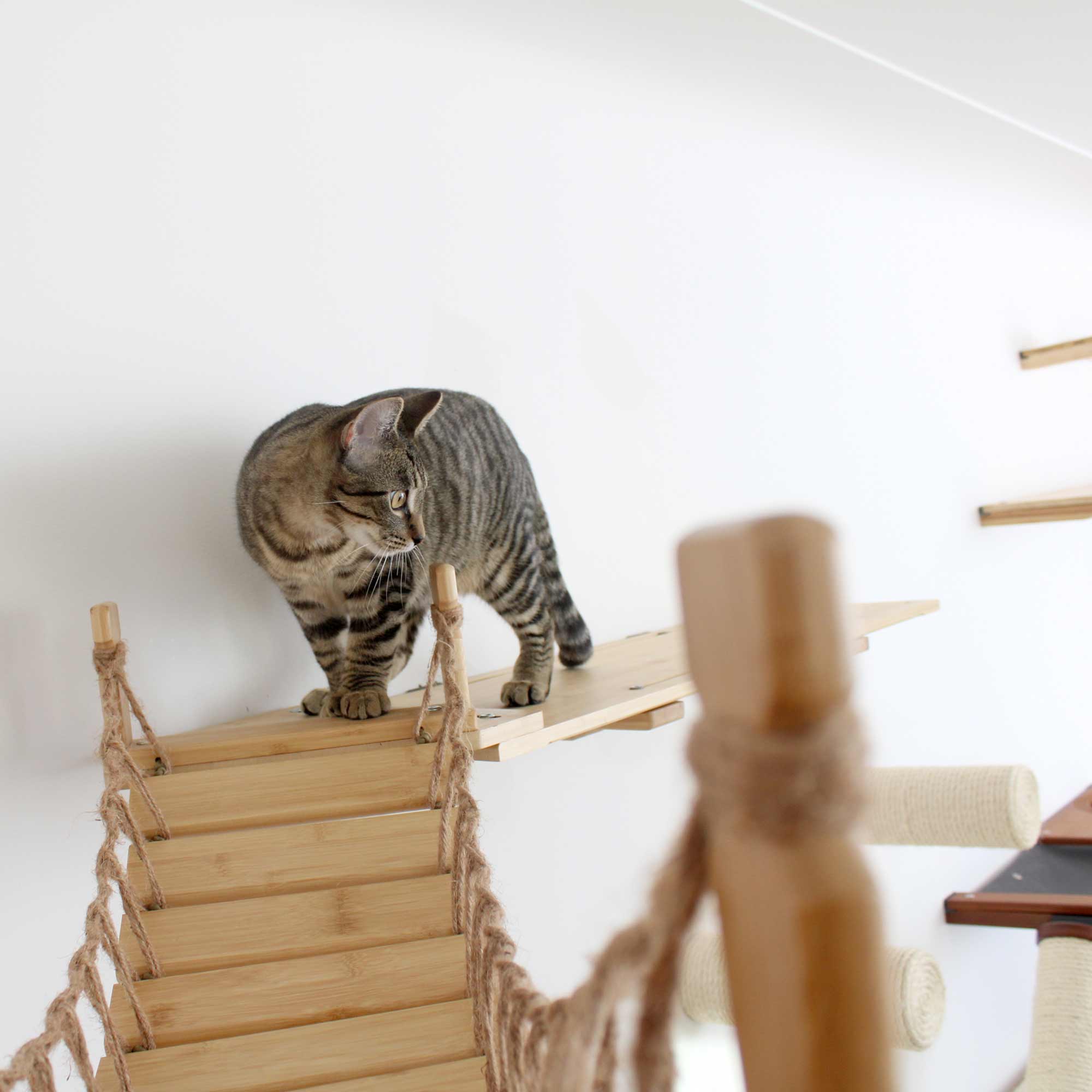
Incorporating Cat Walls Along Doors and Windows
These are perfect locations for Hammocks, Scratching Poles, and Bridges. Our cats especially enjoy any bridge or hammock which are installed in a location where people will pass beneath them. They use this opportunity to paw down at the person’s head as they pass by which is pretty cute.

INSTALLING HAMMOCKS OVER DOORWAYS
We've encountered difficulties in mounting our Hammocks over doorways. The challenge arises because the grommets are spaced in 8" sections along the fabric, whereas doorways vary in width.
Ensuring that the fabric is pulled tightly is crucial for the Hammock's stability, allowing your cat to walk on it comfortably. In the doorway shown, we used a hammock which was eight grommets long.
In our latest furniture collection, we've made a transition to sending out fabric in sewn sections, rather than one continuous roll, to simplify the installation process for our customers. However, it's worth noting that a longer section of fabric is required for this purpose.
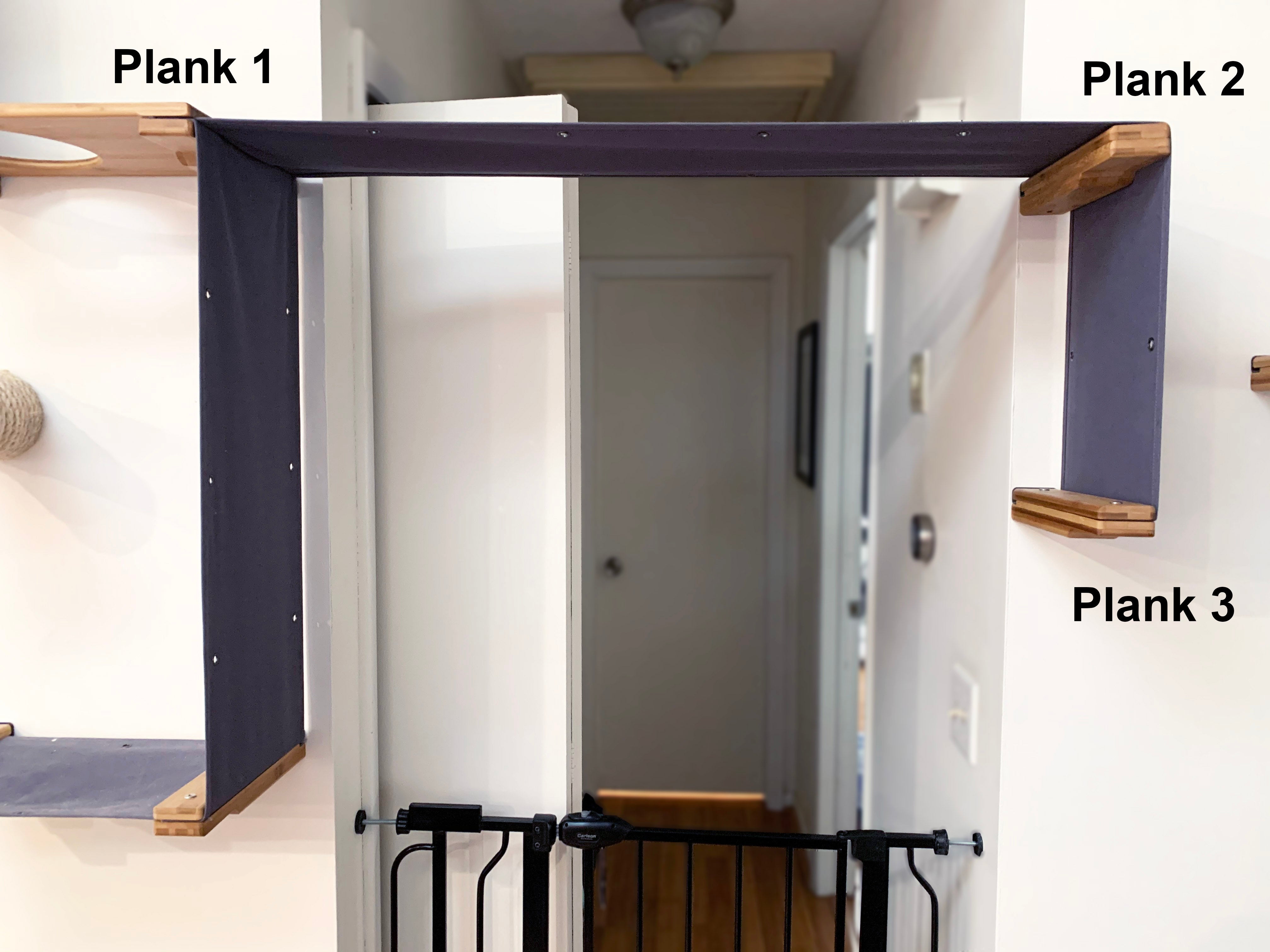
- Start by locating the stud closest to the edge of the doorway. All doorways in homes with wooden doors are framed out by 2"x4"s. Mount a plank into that stud.
- On the other side of the doorway, mount another plank .75" lower than you did plank 1. This is because the fabric will be going over the top of the plank.
- Next, attach your piece of fabric to plank 1, stretch it over plank 2, and clamp plank 3 over the last set of grommets, then tightly pull directly down from plank 2 and mark the bottom of the plank with a pencil.
- Next, remove fabric from plank 1, and mount plank 3 into the marked place. Now working backwards, attach fabric to plank 3, stretch it over plank 2, and pull it over to plank 1.
BLOCKING ROUTES
These are some options that can be helpful for various reasons. We often hear about people blocking routes to prevent dogs from accessing their cat's food.
For us, we had two reasons to block routes on this wall. One was to prevent our cats from being able to jump over our pet gate. We originally had a couch against this wall, but we moved it after our cats figured out they could leap over the gate from the couch.
Another issue we had was our heavier cat, Bronson, climbing too high on the wall. He wasn't as agile as our other cats and was also quite heavy, so we worried about him hurting his legs jumping down from too high up.
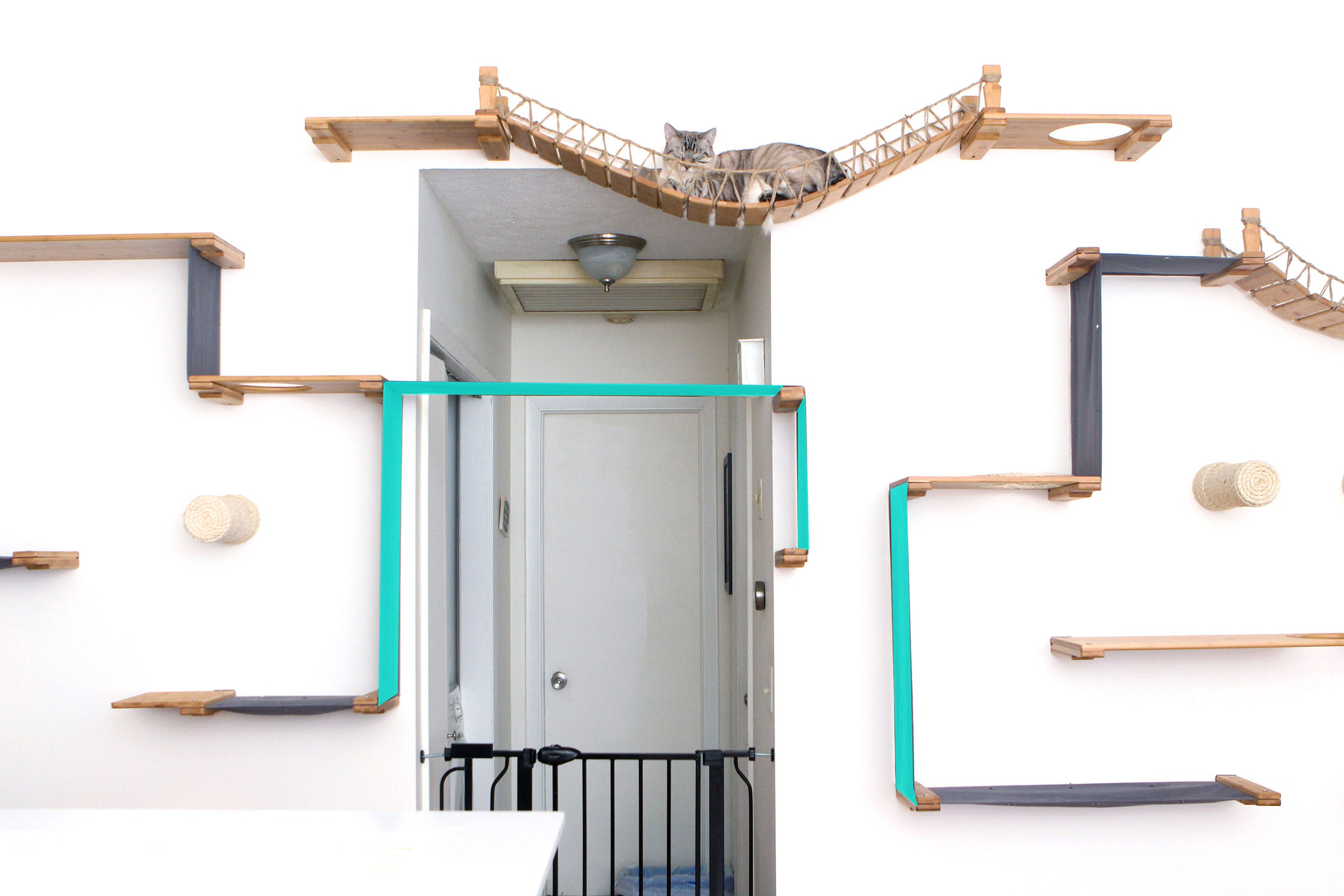
USING FABRIC WALLS
Fabric walls can be a great way to keep cats from jumping to unwanted areas. We've used these in the past to prevent them from jumping to shelves we didn't want them on or wall-mounted TVs.
CREATING AWKWARD JUMPS
The following are difficult routes we designed to try and keep our heaviest cat; Bronson, from getting to the top level. He was never able to get past them.
These are some good options to have before a more advanced level because they need to be agile enough to get there first.
One negative thing with these is that it also makes it more difficult for the other cats to get up. We have noticed that they were up higher more often than before we created these next steps.
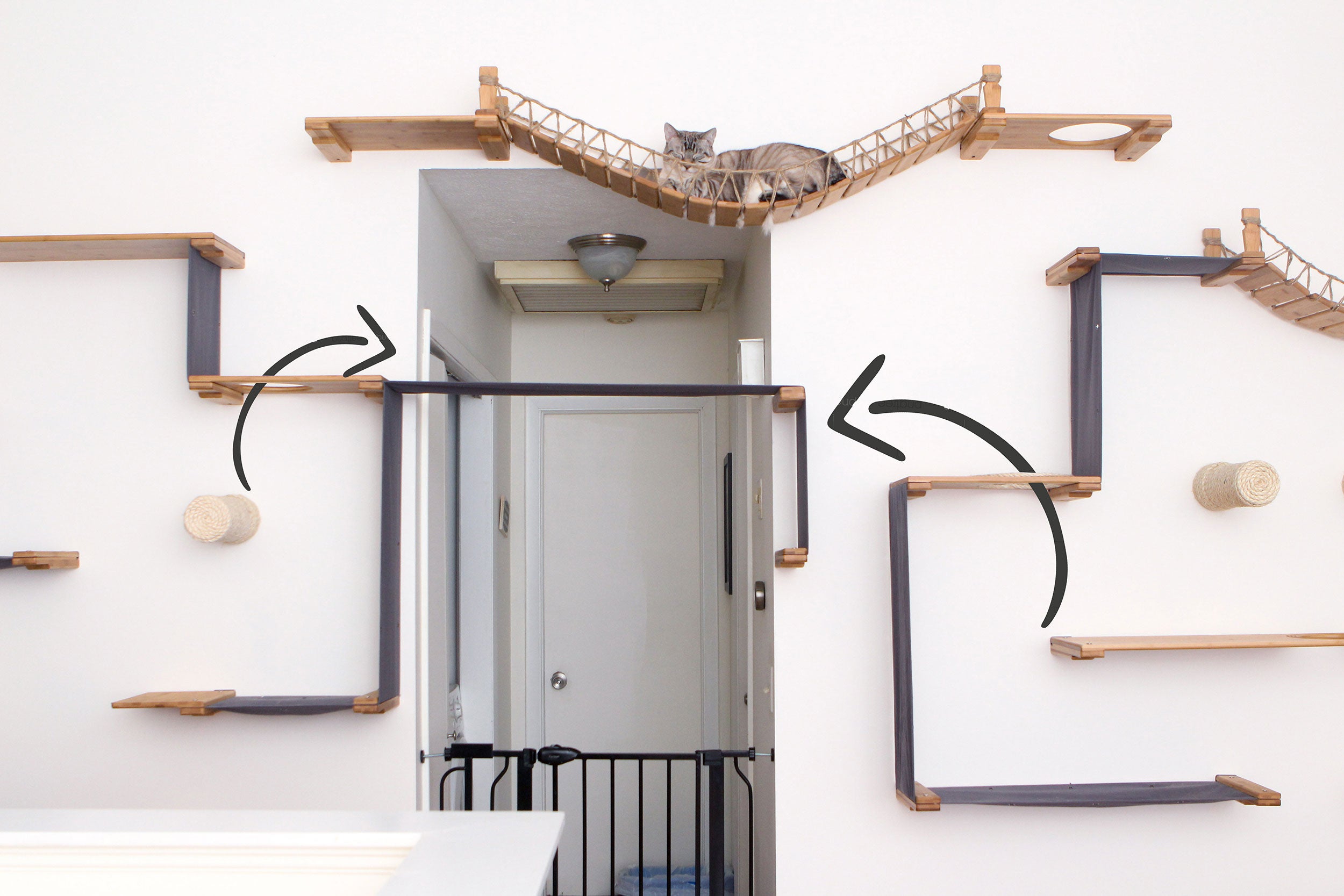
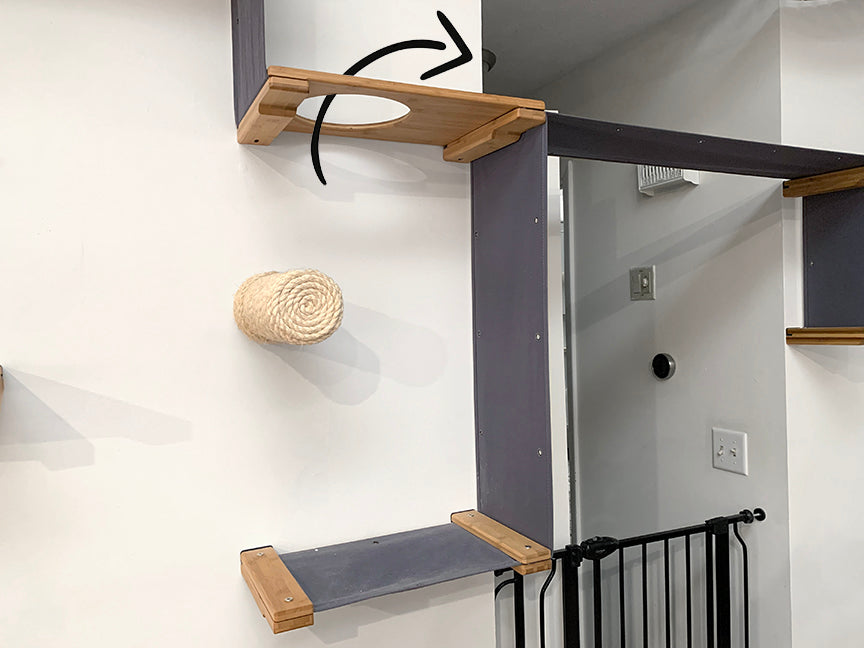
Jumping onto a Sisal Post is something that takes a little agility and balance. Here, we mounted it in a position where it's awkward to jump to, and then the cat needs to be able to jump through the hole from the pole.
Another route was made with Steps, which are smaller shelves meant to be used as stepping stones. Bronson barely fit on these shelves and wasn't able to get past this.
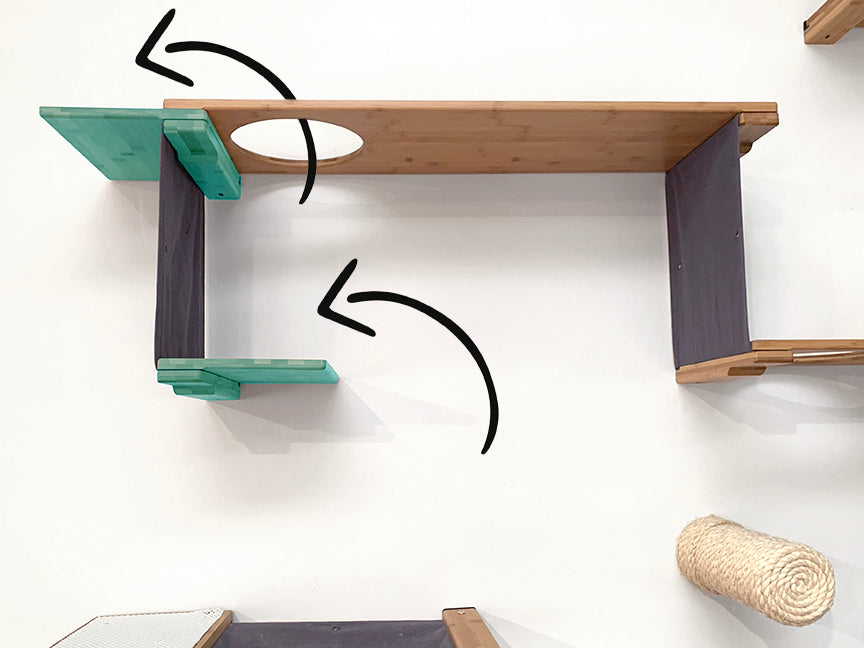
We set up this so that you have to jump from an awkward angle. It's now an area for epic battles. Here's a video of our cat Heisenberg trying to make it seem better on the upper level than it really is.
ADDITIONAL DESIGN ASSISTANCE
If you're interested in some recommendations to best fit your situation and wall space, please send us the following information to support@catastrophicreations.com.
- A few pictures of your wall showing your stud locations marked with painter’s tape - How to locate your wall studs.
- Dimensions of your wall
- Provide us with an idea of which furniture you are most interested in and a little information about your cat(s).
- Your budget range.
Frequently Asked Cat Wall Installation Questions
~Do cat shelves need to be in studs?
In order for your cat wall to be secure for your feline friend, you need to install your cat shelving into studs, concrete, cement, or brick. Drywall alone will not be able to support the weight of your cat playing on their new jungle gym. Even with the help of drywall anchors, you will need at least one mounting point of the cat shelf to be secured into a solid anchor point like a stud.
~How do you make a cat wall tree?
Taking on the project of making a cat tree can be quite an endeavor. We are currently working on a DIY Cat Wall section for our site in order to showcase some of our more interesting projects and builds. For now, you can check out our Catastrophic Ideas & Prototypes page to gain some inspiration. The Chain Chomp Cat Bed was one of our most favorite pieces, and you can follow along with the build here.
~Are cat wall shelves safe?
You know your cat's ability better than anyone. If you know you have a cat that defies the stereotype of grace, keep that in mind when you make your cat wall design ideas. In cases such as these, you may want to consider installing the cat wall closer to the ground, or above a soft landing zone.
Just note, as long as you are installing the wall-mounted cat furniture securely into solid anchoring points (like studs or cement), your cat shelf will be able to withstand your cats at play!
~What is the spacing for cat wall steps?
In general, we suggest you design your cat wall to have 12-16” between shelves horizontally, and 12-18” spacing vertically. You will always want to be mindful of your cats’ abilities when installing your cat jungle gym to make them the purrfect playground!

